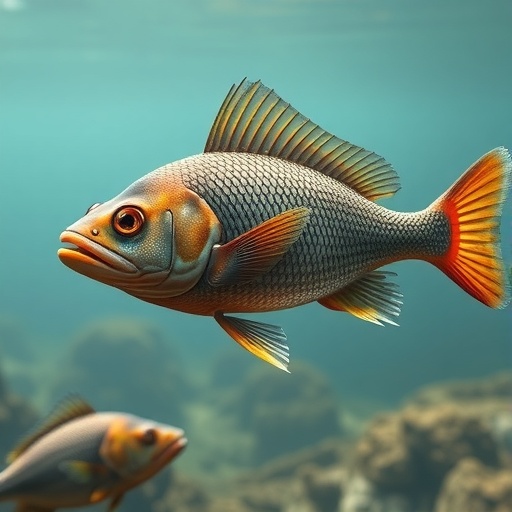In a groundbreaking study that is reshaping our understanding of vertebrate evolution, an international team of scientists led by the Canadian Museum of Nature and the University of Chicago has unveiled a remarkable reconstruction of the brain, heart, and fins of an extinct jawless fish species, Norselaspis glacialis. This tiny fossil, scarcely larger than a fingernail and dating back more than 400 million years to the Devonian Period, reveals an unexpected complexity in early vertebrate anatomy, challenging long-held assumptions about how evolutionary innovations emerged.
For decades, the evolutionary narrative has centered on the rise of jaws as the defining innovation enabling vertebrates to transition from simple bottom-dwelling creatures into agile, predatory swimmers dominating the water column. The paradigm held that structural changes supporting predatory habits, such as enhanced sensory organs and improved locomotion, followed the advent of jaws and teeth. However, by leveraging state-of-the-art imaging technologies, this new research overturns the “jaws-first” hypothesis, demonstrating that sophisticated sensory and circulatory systems developed well beforehand in jawless ancestors.
The exceptional preservation of the Norselaspis fossil lies at the core of this discovery. Retrieved from sandstone blocks collected in Spitsbergen, Norway, during a 1969 paleontological expedition, the fossil’s cranium is barely half an inch long yet holds a wealth of anatomical data. Using powerful high-energy X-ray beams at the Paul Scherrer Institute in Switzerland, researchers scanned the fossil slice by slice. These scans revealed delicate, tissue-thin layers of bone that cast ghostly shadows of soft organs such as the brain, inner ears, heart, and even the minute muscles controlling eyeball movement. This unprecedented level of detail presents Norselaspis in anatomical resolution rivaling that of many extant fish.
Dr. Tetsuto Miyashita, lead author and research scientist at the Canadian Museum of Nature, emphasizes the significance of these findings: Norselaspis possessed a sensory suite and circulatory system indicative of an active, awareness-driven lifestyle long before jaws appeared. The fish had seven small muscles orchestrating eye movements—a contrast to the six found in humans—and oversized inner ears facilitating precise detection of vibration, orientation, and acceleration. Most strikingly, its heart was proportionally enormous, framed by a complex vascular system configured to shuttle blood efficiently and power a high-energy mode of life.
These physiological adaptations are reminiscent of modern apex predators, offering what Miyashita describes as a “heart of a shark beneath the skin of a lamprey.” Complementing this extraordinary cardiovascular capacity were paddle-like fins positioned behind the gills, enabling sudden directional changes and bursts of speed. Such agility likely evolved as an essential survival strategy to evade predators, not necessarily to pursue prey actively.
Michael Coates, Professor and Chair of Organismal Biology and Anatomy at UChicago and senior author, elaborates on the evolutionary context: the innovations seen in Norselaspis provided a functional and ecological framework that would later allow jawed fishes to exploit prey capture more effectively. Instead of jaws catalyzing all changes, this research paints a picture of sensory, circulatory, and locomotor upgrades setting the stage for the subsequent emergence of jaws.
Of particular note is the study’s challenge to a long-standing anatomical hypothesis regarding the evolution of tetrapod shoulders and arms. By tracing the nerve supplying the shoulder in Norselaspis, the team found that its neural connections were independent of those innervating the gills. This directly contradicts the idea that these structures derived from modified gill arches. Instead, the shoulder appears to have evolved as a novel anatomical domain, distinct from gill architecture, signaling an early development of a neck region separating head and torso.
This structural separation is pivotal; in primitive jawless fishes, the head is continuous with the trunk, whereas jawed vertebrates possess a neck and throat to decouple the two regions. Norselaspis represents an intermediate stage where the head is still attached without a distinct neck, akin to arms protruding from behind the cheeks in a hypothetical human analogy. This configuration underscores a transitional anatomical design, integrating enhanced sensory organs and cardiovascular features at the head-trunk interface to optimize environmental navigation.
This evolutionary snapshot also sheds light on the broader “Nekton Revolution,” a transformative epoch when marine organisms began exploiting midwater habitats, driving a shift toward increased speed, sensory acuity, and maneuverability. Christian Klug of the University of Zurich, who was not involved in the study, suggests that Norselaspis belongs to this lineage thriving in such dynamic ecological niches, supporting the idea that evolutionary pressures favored enhanced swimming and sensory mechanisms before the acquisition of jaws.
In totality, the study reframes vertebrate evolution as a complex, multi-faceted process rather than a series of sudden innovations centered solely around jaws. The intricate anatomy uncovered in Norselaspis accentuates the importance of gradual acquisitions—advanced sensory capabilities, cardiovascular enhancements, and locomotor refinements—that predated and likely facilitated the advent of jawed predators.
Dr. Miyashita aptly cautions against oversimplifying these evolutionary milestones. “The evolution of jaws has often been likened to a singular trigger event, like the gunshot in Sarajevo that started World War I,” he says. “But to truly grasp the magnitude of this evolutionary chapter, one must understand the nuanced context—the environmental, physiological, and anatomical shifts embodied in creatures like Norselaspis.”
This study exemplifies how technological advances in imaging and fossil analysis are peeling back layers of deep evolutionary history, revealing the complexity and sophistication of early vertebrates. It sets a new standard for future investigations into the origin of fundamental vertebrate features, demonstrating that pivotal evolutionary transformations involve an interplay of multiple, concurrent adaptations rather than isolated innovations.
Subject of Research:
Animal tissue samples
Article Title:
Novel assembly of a head–trunk interface in sister group of jawed vertebrates
News Publication Date:
6-Aug-2025
Web References:
DOI: 10.1038/s41586-025-09329-9
Image Credits:
Kristen Tietjin
Keywords:
Norselaspis glacialis, jawless fish, vertebrate evolution, Devonian period, fossil reconstruction, brain anatomy, heart morphology, inner ear, high-energy X-ray imaging, head-trunk interface, jaw evolution, sensory adaptation, Nekton Revolution




